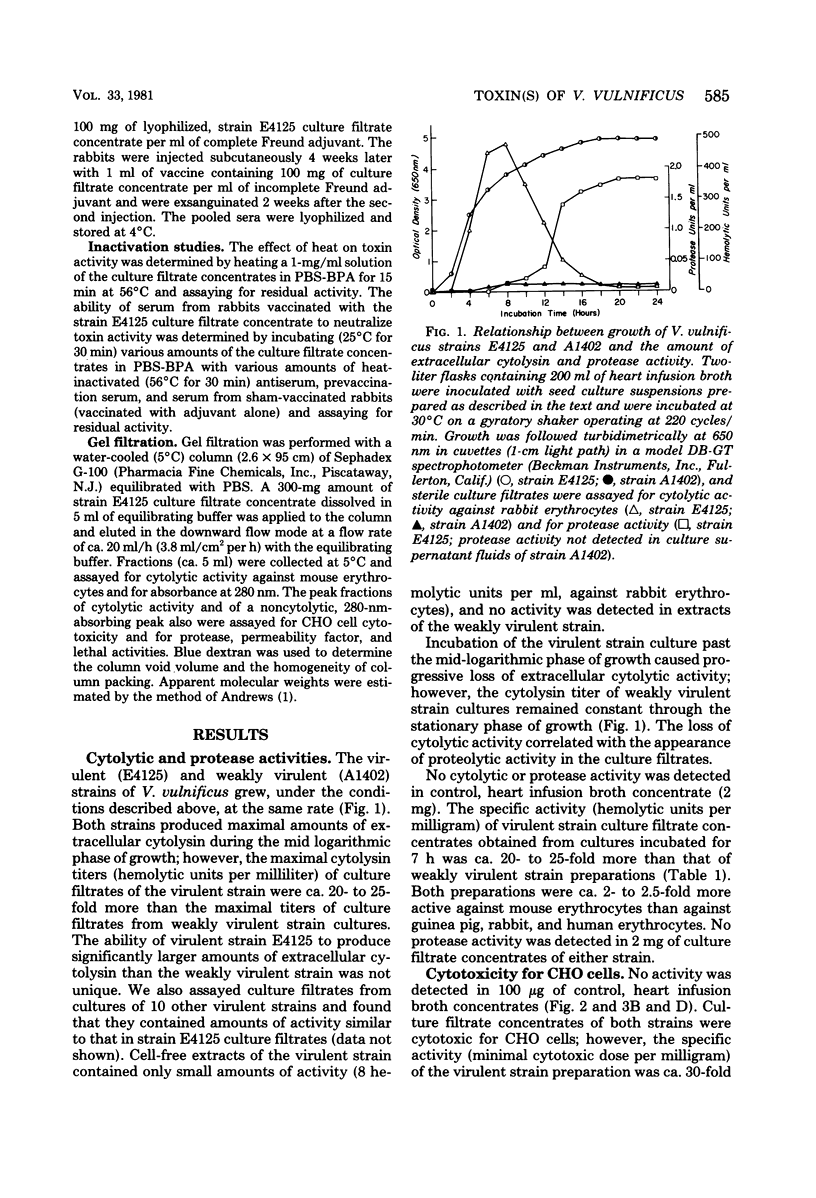Abstract
Conditions are described for the production, in high titers, a heat-labile, antigenic, extracellular toxin(s) by Vibrio vulnificus, a recently recognized human pathogen. Bacteriologically sterile culture filtrate preparations obtained from mid-logarithmic-phase cultures of the bacterium possessed cytolytic activity against mammalian erythrocytes, cytotoxic activity for Chinese hamster ovary cells, vascular permeability factor activity in guinea pig skin, and lethal activity for mice. The specific activity of toxin preparations from cultures of a virulent strain of the bacterium was ca. 25-fold more than that of toxin preparations obtained from cultures of a weakly virulent strain. The four toxic activities were inseparable by gel filtration with Sephadex G-100; however, two components, which had markedly different elution behavior but which possessed the four activities mentioned above, were obtained. The major (ca. 88% of the recovered activity) and minor components had apparent molecular weights of ca. 38,500 and greater than 150,000, respectively.
Full text
PDF







Images in this article
Selected References
These references are in PubMed. This may not be the complete list of references from this article.
- Andrews P. Estimation of the molecular weights of proteins by Sephadex gel-filtration. Biochem J. 1964 May;91(2):222–233. doi: 10.1042/bj0910222. [DOI] [PMC free article] [PubMed] [Google Scholar]
- BERNHEIMER A. W., SCHWARTZ L. L. Isolation and composition of staphylococcal alpha toxin. J Gen Microbiol. 1963 Mar;30:455–468. doi: 10.1099/00221287-30-3-455. [DOI] [PubMed] [Google Scholar]
- Blake P. A., Merson M. H., Weaver R. E., Hollis D. G., Heublein P. C. Disease caused by a marine Vibrio. Clinical characteristics and epidemiology. N Engl J Med. 1979 Jan 4;300(1):1–5. doi: 10.1056/NEJM197901043000101. [DOI] [PubMed] [Google Scholar]
- Blake P. A., Weaver R. E., Hollis D. G. Diseases of humans (other than cholera) caused by vibrios. Annu Rev Microbiol. 1980;34:341–367. doi: 10.1146/annurev.mi.34.100180.002013. [DOI] [PubMed] [Google Scholar]
- Carpenter C. C. More pathogenic vibrios. N Engl J Med. 1979 Jan 4;300(1):39–41. doi: 10.1056/NEJM197901043000111. [DOI] [PubMed] [Google Scholar]
- Farmer J. J., 3rd Vibrio ("Beneckea") vulnificus, the bacterium associated with sepsis, septicaemia, and the sea. Lancet. 1979 Oct 27;2(8148):903–903. doi: 10.1016/s0140-6736(79)92715-6. [DOI] [PubMed] [Google Scholar]
- Fernandez C. R., Pankey G. A. Tissue invasion by unnamed marine vibrios. JAMA. 1975 Sep 15;233(11):1173–1176. [PubMed] [Google Scholar]
- Ghosh H. K., Bowen T. E. Halophilic vibrios from human tissue infections on the pacific coast of Australia. Pathology. 1980 Jul;12(3):397–402. doi: 10.3109/00313028009077102. [DOI] [PubMed] [Google Scholar]
- Hollis D. G., Weaver R. E., Baker C. N., Thornsberry C. Halophilic Vibrio species isolated from blood cultures. J Clin Microbiol. 1976 Apr;3(4):425–431. doi: 10.1128/jcm.3.4.425-431.1976. [DOI] [PMC free article] [PubMed] [Google Scholar]
- Iglewski B. H., Sadoff J. C. Toxin inhibitors of protein synthesis: production, purification, and assay of Pseudomonas aeruginosa toxin A. Methods Enzymol. 1979;60:780–793. doi: 10.1016/s0076-6879(79)60071-x. [DOI] [PubMed] [Google Scholar]
- Kao F., Chasin L., Puck T. T. Genetics of somatic mammalian cells. X. Complementation analysis of glycine-requiring mutants. Proc Natl Acad Sci U S A. 1969 Dec;64(4):1284–1291. doi: 10.1073/pnas.64.4.1284. [DOI] [PMC free article] [PubMed] [Google Scholar]
- Kelly M. T., Avery D. M. Lactose-positive Vibrio in seawater: a cause of pneumonia and septicemia in a drowning victim. J Clin Microbiol. 1980 Mar;11(3):278–280. doi: 10.1128/jcm.11.3.278-280.1980. [DOI] [PMC free article] [PubMed] [Google Scholar]
- Kreger A. S., Gray L. D. Purification of Pseudomonas aeruginosa proteases and microscopic characterization of pseudomonal protease-induced rabbit corneal damage. Infect Immun. 1978 Feb;19(2):630–648. doi: 10.1128/iai.19.2.630-648.1978. [DOI] [PMC free article] [PubMed] [Google Scholar]
- Matsuo T., Kohno S., Ikeda T., Saruwatari K., Ninomiya H. Fulminating lactose-positive Vibrio septicemia. Acta Pathol Jpn. 1978 Nov;28(6):937–948. doi: 10.1111/j.1440-1827.1978.tb01282.x. [DOI] [PubMed] [Google Scholar]
- Mertens A., Nagler J., Hansen W., Gepts-Friedenreich E. Halophilic, lactose-positive Vibrio in a case of fatal septicemia. J Clin Microbiol. 1979 Feb;9(2):233–235. doi: 10.1128/jcm.9.2.233-235.1979. [DOI] [PMC free article] [PubMed] [Google Scholar]
- Poole M. D., Oliver J. D. Experimental pathogenicity and mortality in ligated ileal loop studies of the newly reported halophilic lactose-positive Vibrio sp. Infect Immun. 1978 Apr;20(1):126–129. doi: 10.1128/iai.20.1.126-129.1978. [DOI] [PMC free article] [PubMed] [Google Scholar]
- Roland F. P. Leg gangrene and endotoxin shock due to vibrio parahaemolyticus--an infection acquired in New England coastal waters. N Engl J Med. 1970 Jun 4;282(23):1306–1306. doi: 10.1056/NEJM197006042822306. [DOI] [PubMed] [Google Scholar]
- Thorsteinsson S. B., Minuth J. N., Musher D. M. Clinical manifestations of halophilic non-cholera Vibrio infections. Lancet. 1974 Nov 30;2(7892):1283–1284. doi: 10.1016/s0140-6736(74)90141-x. [DOI] [PubMed] [Google Scholar]
- Weaver R. E., Ehrenkranz N. J. Letter: Vibrio parahaemolyticus septicemia. Arch Intern Med. 1975 Jan;135(1):197–197. doi: 10.1001/archinte.135.1.197. [DOI] [PubMed] [Google Scholar]
- Zide N., Davis J., Ehrenkranz N. J. Fulminating vibrio parahemolyticus septicemia. A syndrome of erythemia multiforme, hemolytic anemia, and hypotension. Arch Intern Med. 1974 Mar;133(3):479–481. doi: 10.1001/archinte.133.3.479. [DOI] [PubMed] [Google Scholar]





